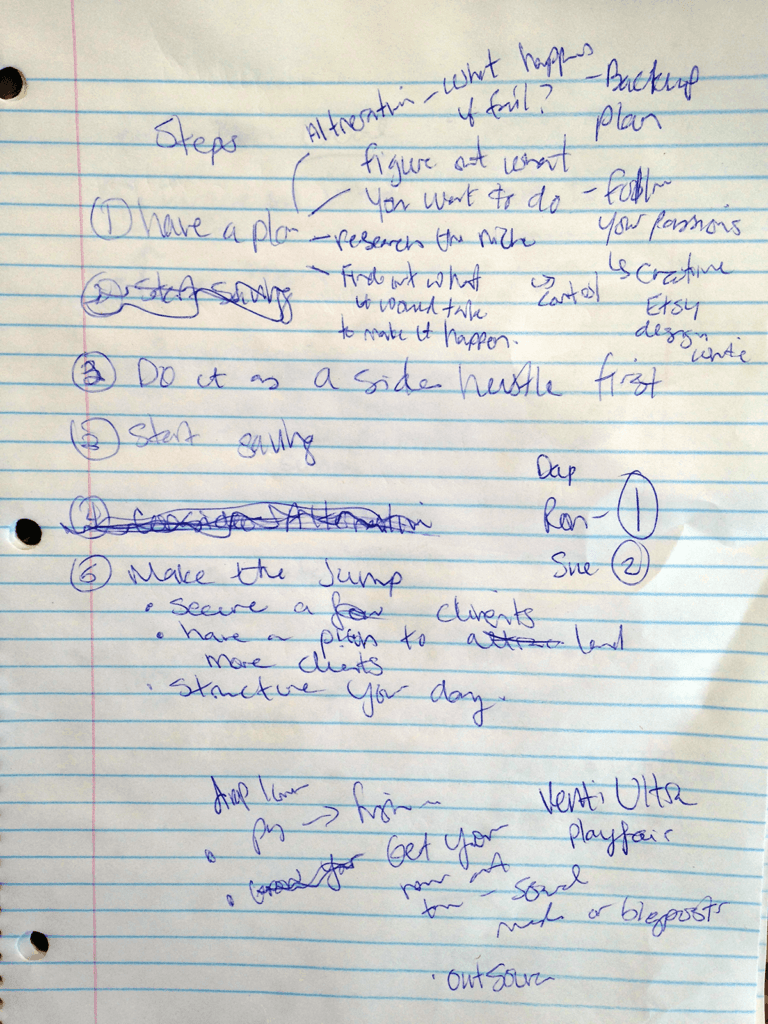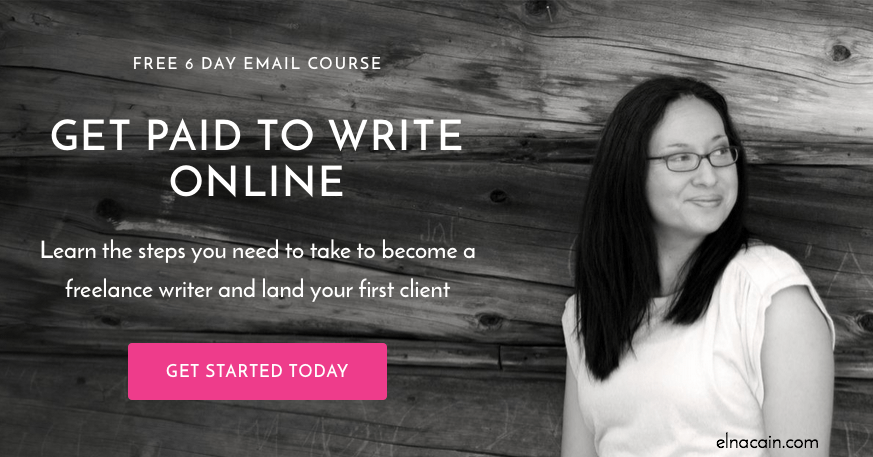What’s your writing process?
I’ve been a freelance writer for a little over a year now and I am still finding my groove when it comes to writing my client pieces.
I’m a mother to twin toddlers and distractions are a normal part of my day. So, I know having a system in place is crucial to the success and outcome of my freelance writing business.

Right? If I can streamline my writing process, I’ll complete projects faster and then have more time to work on my course, coaching and any side projects I’m drumming up.
So, I thought I’d round up some freelance writers and bloggers and ask them about their writing process.
I always like to see what other freelance writers are doing to manage a successful business.
But, before we look at how others structure their writing process, I’ll give you a run down on how I do it.
My Writing Process
Clients either pitch me topics or I pitch them topics. When I pitch topics to clients I automatically create a loose outline for them.
When a client pitches me topics, I file it for later and go back to it when I have time to write those pieces.
When it’s time, I typically think of a working headline (which almost always resembles the finished headline) and write out (with pen and paper) my outline.

Yes, my outlines are really like this.
From here, I start doing research, finding stats and examples to strengthen my post. I always work top-down.
This means I start with the introduction and work my way down until I come to the conclusion. I never skip around, I never start mid-way and I don’t tend to work on several pieces at once.
I stick to one post, and work on it until it’s finished (the first draft) and then move on to the next assignment.
Once my draft is complete, it goes through a rigorous editing process (I explain this in detail in my course). From here, I finalize the images by optimizing them or annotating them, compress them and put them in a zip file for clients (or upload into their CMS).
There ya go! Let’s look at how these bloggers and writers process their writing. You might be surprised at how varied everyone is.
1. Raymonda Rice – Professional Writer and Editor
I write in a mixture of 1st and 2nd person. I might end up with 3 paragraphs in the 1st person and 2 paragraphs in the 2nd person. But there really is a method to my madness!
So, before I write on a topic, I like to pretend that a good friend has sat me down to have a serious discussion. I pretend they need some really good advice to solve the problem they’re having. And then I try to imagine how our conversation would go.
In real life, people talk in a mixture of 1st and 2nd person. And that’s why I tend to write everything in a mixture of 1st and 2nd person – it helps me think of the article in terms of a conversation.
When I think of writing an article like that, it becomes so much easier for me to do it. The first time I had to write a 1500 word article on a topic, I stressed out so much. I didn’t know where I would find 1500 words to write about on a topic for a complete stranger! And every time I sat down to write, the words just would not come.
That’s when I realized that I needed a writing process. By implementing the idea of talking to a friend (or ideal reader), I was able to easily write 1500+ words in the matter of hours because I knew exactly what to say to a good friend!
I thought it might seem like double work at first, but it’s not since I edit everything I write anyway. And it’s not much trouble turning an “I” sentence into a “you” sentence.
It might seem a bit odd to my family watching me have an imaginary conversation with myself about x ways to grow your business, but whatever works I say! Follow me @noodlepower.
Get My Free Course on Getting Paid to Write Online
2. Heather Bloomer – Freelance Writer
When I get an idea for a blog post I’ll start it up as a draft in WordPress. Once I have a basis for what I want to write about I just let it flow if, it’s there, from top to bottom.
If, I need some time to let things brew to get my words in order, I’ll take a break. I’ll let it simmer and add to it as my focus comes back to the post.
I find that once I have some content for each section of my post, I’ll go back in and add more. I elaborate further or create a clearer message in sections that need it.
When writing for a client, I go through a similar writing process. I start out with a draft in Microsoft Word to keep a copy on my MacBook. I write from top to bottom, then enhance and add more writing where it’s needed.
Once something is down from top to bottom, then I can add more wherever it’s needed. I make my writing personable. As you know different clients will have different styles they want you to write with. So its best to write by their rules, but don’t lose your style while doing this. Follow me @BloomerHeather.
3. Alicia Rades – Y/A Author
Once my client and I have agreed on an idea, I start by outlining my subheads.
Basically, I want an idea of what I’ll cover in the post. If I
need to explain the idea behind the subhead or make sure I mention a specific statistic or example, I’ll add a note of it in the outline.
Then I run a Google search for any statistics or resources I can use in the blog post. Sometimes this will turn up new points I can add to the post that I
hadn’t thought of before.
Then, I simply get to writing! I start with the intro, but sometimes I’ll also write the conclusion right away so I know how much word count I’ll have for each subhead.
I wouldn’t say there’s anything particularly special about my writing process. I typically write in Microsoft Word and start at the beginning and work my way to the end. Follow me @aliciarades.
4. KeriLynn Engel – Freelance Writer and Professional Blogger
My writing process usually starts with an outline. I write a bulleted list of the main points I want to cover, making sure the piece has a logical structure and flow. I have an idea of what my main subheadings will be, though they may change a little when I start writing. I try to come up with a hook for the intro – some idea of how I’ll reel in readers.
Next, I write a really terrible first draft.
I kind of hate writing first drafts, so I try to write it as quickly as possible. I don’t worry about whether it sounds good or makes much sense. I write whatever comes to mind, whether it’s silly and ridiculous, or really boring, or just plain bad.
I make sure the word count is at about 125-150% of what the final count should be, because I’ll probably need to cut out some fluff and repetition.
Then I let it rest.
I give it enough time so that I can forget what I wrote and be more objective when editing. It needs at least several hours, but if I can give it at least a day or two, I can be even more objective. The editing stage is a lot easier for me.
I take what I was trying to say, and rearrange it to make more sense and flow better. Grammar and spelling have always come pretty naturally to me, so the editing is more about structure and flow, and removing fluff and repetition. Sometimes it surprises me that my drafts aren’t as horrible as I thought they were, but sometimes they really are horrible 🙂
If I have time, I’ll let it rest another day or two and give it another final polish.
5. Lizzie Davey – Freelance Writer
I start by outlining a post. I’ll come up with a working title which usually changes by the end, but I’ll use that to map out the key points I want to make.
Within those key points, I’ll hone it down further into a couple of bullet points that I want to cover within that section. When I have the major points I want to cover and the sub-points mapped out within those, I start writing.
Sometimes I’ll start from the very beginning if I have a story to lead with (these often come to me when I’m waiting for the kettle to boil – who knows why!), but often I’ll just start writing from the first key point.
I’ll then fill in all the info in each section and go back and read it over. Then it’s time to nail down the introduction – if I’ve already written it, I might edit it to make it snappier – and the ending (I like to loop things back round to the introduction here).
When everything is in place, I’ll do a quick search on Google or BuzzSumo for articles that I can link out to that will add some oomph to my post, and then I’ll do one final read through and edit.
Whenever I’m writing a blog post – whoever it’s for – I continuously ask myself “what is the reader getting out of this?” If I can’t come up with an answer, I edit it until I have one!
6. Deevra Norling – Freelance Writer
I’m really just a simple top-to-bottom writer. I start with the introduction and work my way down from there and that’s it. There are times when the biggest challenge is the start – those times when I feel blank.
That’s very frustrating because I’m not one of those writers who can start in the middle or anywhere else in a piece and then go back to the intro.
Perhaps it has to do with my logical and methodical brain, I don’t know!
But I have to start from the top. Once I start and get past the block it just flows from there. If I’m doing a list article then I will think about the points I want included in the list and write it down so that I don’t forget. And with headings, sometimes the heading is the first thing I have down and other times I only think up the heading after the piece is done. Follow me @DeevraNorling.
7. Mariken Zuydgeest – Freelance Writer
I realized that my writing process is as diverse as the pieces that I write. When I have pitched something I pretty much follow the outline I have set out (and have most of the information to start with) and it becomes more of a fill-in-the-blanks piece.
Often however when it’s one of my blogs, it may start with just a thought or realization and I build upon it until it comes together.
I love to do ‘tips’ features and then depending on the research I do, the set up may change a few times until I find the one that suits that particular medium best like the SEO guest post for Freelancer FAQs.
At first I wanted to highlight some of the lesser known techniques for writing, or tips that might get overlooked but then decided to include more generic information and tips as not everyone will be aware of the technical parts of making your website work for you.
For more involved pieces, I use, and may draw, the inverted pyramid to help structure my information in the best possible way, therefore usually from a bottom-up perspective. Follow me @Meltszee.
8. Brenda Pace – Blogger and Virtual Assistant
Generally, my writing begins with a post-it note that either came from my bathroom, bedroom, or Jeep. When I get ideas, I have to jot them down or I’ll forget by the time I go to write the article. I have post-its and mini notepads EVERYWHERE!
From the post-it or notepad, content is born.
I can write from the comforts of two different couches in my home, my home office, or my mini office in my living room. Other times, I’m creative during the daytime and will write during my lunch break at work.
Sometimes I’ll hand write it out, depending on where I am. Other times, I’ll create in Google Docs or MS Word. When I’m feeling very foggy, I’ll write directly into my WordPress editor. This is where I prefer MS Word over the WordPress editor because I can use Grammarly to help me out. 🙂
Once I get the basics down, I scour the internet for facts and stats to include. We all love those, right? Next to create headings 1, 2, and 3 as necessary, add italics, quotes, or even Click to Tweet content. Bulleted or numbered lists are super awesome so I usually throw one or the other in there.
Proof once, twice, and maybe thrice before I add images and schedule the post or publish right away.
9. Elise Moreau – Freelance Writer
I’ve heard that many writers will write out their headlines only after they’ve finished writing the main content, but I always start with writing the headline out first so I can see it at the top of the page.
I often change it or tweak it later, but it helps to see it there so I can get clear about the subject matter and stay on topic as I’m writing.
If it’s a list post, I like to list out all the items right after finishing the intro, which I guess sort of acts like an outline for me. I use the same approach if it’s an article with subheadings. Then I’ll do my research and work my way down each item or subheading to write out the corresponding content.
I used to be a really distracted writer, so now I use the Pomodoro productivity technique to stay focused and work more efficiently.
It involves getting laser-focused and working toward completing just one task for 25 minutes straight, followed by a five-minute break. (After four rounds, there’s a longer break.) I close every tab open in my browser that could distract me, put on my headphones to listen to some ambient music and use a Pomodoro timer app on my smartphone to get through each mini workflow chunk. I pretty much swear by this technique!
10. Cori Ramos – Blogger
 This might seem a little strange but this process works for me. When I’m putting a blog post together it’s usually put together in pieces and with at least two edits before publishing.
This might seem a little strange but this process works for me. When I’m putting a blog post together it’s usually put together in pieces and with at least two edits before publishing.
I start with the topic I want to write about and give it a general title. Then I begin writing the main topic or the “meaty” part of the blog post.
While I’m putting that together an idea for an opening or closing might pop in my head, so l start a new paragraph and write it out so I won’t forget. Then I go back to the main part of the post.
Once I’m done with the first draft I go back to edit and add the subheadings and give it a better title.
The day before publishing the post I give it another look to make sure I’ve got all the elements and make any changes or add to the post if I see there is more information I can provide.
I give it a final review and schedule the post for publishing. Follow me @NotNowMomsBusy.
11. Cheri Read – Freelance Writer
I’m still a pen and paper kind of gal, so as soon as I get an assignment, I tend to jot down my main points while it’s fresh on my mind. I will then print out any articles I’m using for research and staple the note page on top. I rarely create a full outline, but work directly from rough notes.
Basically, I write all of my points on sticky notes and arrange them in a way that makes sense. As I cover each point, I throw away the note. It kind of gives me a sense of accomplishment as the notes start to disappear!
12. Angela Nelson – Blogger
I start with my subheadings or a quick outline so I have a clear direction on where I want the piece to go and what information is most important to include.
I then move on to the sections that require little, if any, research. I save the most difficult sections until the end when I can focus on the details and get specific. And, I almost always create my introduction last as this is the most important part of your article.
A poor introduction can turn a reader away before they even reach the meat of your content. Follow me @thewahwife.
13. Pinar Tarhan – Freelance Writer
My writing process varies when I’m writing for myself, but when I’m writing for a client or submitting to a site that I pitched, I read a few of the blog posts. I study for word count, style, link numbers…etc.
Then I write a draft first. I usually outline in my head, but I don’t write the outline down. After I finish the initial draft, I rewrite so that the style fits the blog’s perfectly. Then I edit and proofread. But because I studied the blog first, even my initial draft doesn’t take too much effort to turn into something good. Follow me @zoeyclark.
14. Carrie Smith – Freelance Expert and Writer
I start by opening a blank Google Doc on my computer. (I complete all of my freelance writing assignments and blog posts in Google Docs, even if my clients have a content management platform. That way I always have a backup copy in the event the site is lost or deleted.)
Then I insert the title and start creating a brief outline of the points I plan on making. Then I write out a few thoughts about what each point will include, as well as any opening or closing notes.
Usually at this point I close the doc and come back to it within a day or two. This allows me time to completely flesh out any additional details or points, or insert quotes for interviews.
Next I’ll start working on each point in-depth and compose it with stats and other anecdotes. I prefer to start with a point that I’m excited to write instead of beginning with the introduction, which can stump me up and stifle my creative ideas for the entire piece.
Finally, I fill in the rest of the points, add an intro and complete everything with a simple closing. I’ll give it several edits for grammar and flow before turning it in or publishing it. That’s it! My process is spread out over several days but batching my work into idea generating, writing and editing segments allows me to be much more productive. Follow me @carefulcents.
15. Patricia Vaz – Freelance Writer
I usually keep the central theme that has to be followed as the main focus of the post and find keywords accordingly.
Next is to try and research what has already been covered on other posts and try to make it as unique and relevant to the reader who is searching for specific answers. In this context, I then pick the main points that will form a part of the blog post, convert them into headings and sub-headings and work on what should be covered in each of the sub-headings.
The idea while writing is to understand what the reader wants to read rather than what I would want to write in the blog post. Thinking as if I’m having a conversation with my reader makes the work of writing much more easy. The introduction is usually a light read where I place myself in the
reader’s shoes. This helps connect with the reader at some level. The middle portion of the post covers the topic in detail and is the juicy meaty part. The conclusion is usually brief in a sentence or two. Follow me @Pat_256.
16. Adam Zetterlund – Professional Writer
I find I produce my best work when I’m unbridled by complicated outlines. Instead of carefully planning every step of an article, I prefer to hammer out the key subheadings before I begin and then, let inspiration take control.
After writing my piece, I’ll carefully review it and edit as necessary, before submitting to my clients. It’s an admittedly simple method, but I enjoy embarking on the writing process without feeling encumbered by a bulky outline.
17. Kate Muller – Professional Writer and Editor
My writing process actually varies from project to project, but what stays consistent is my compulsive need to create an outline before putting pen to paper.
Even if it’s just a rough summary of the concepts, thoughts, and/or ideas that I want to cover within each mini section, I need to make sure that I’m organized before I commit to writing a single word. It allows me to map out my plan of attack more effectively and enables me to stay on task.
It doesn’t matter what I’m writing, I always have the most trouble with the opening. For that reason, I save that part for last.
If I’m writing a listicle type piece or a post with very specific topics, I tend to start from the top with the ultimate goal of working my way down. But that almost never happens. I have a habit of jumping around from topic to topic whenever I need a break from writing about one specific thing.
As for my titles and subheadings, I usually jot down a few different ideas, throw them against the wall, and see which ones stick.
18. Lenka Podzimek – Freelance Writer and Editor
As soon as I am assigned a topic for a post, my mind immediately begins to mull over ideas and possible angles. Getting these down on paper is crucial for me so I usually scribble them down on the nearest piece of paper I can find!
Then I head over to the computer to organize my ideas into an outline with subheadings and free write some of the content. I usually write whatever pops into my mind, and then clean it up later.
Next comes the research phase, where I look for all kinds of reference material to learn more about my assigned topic. I read a LOT of content so that I can flesh out the post with accurate and current information. I strive to look for reputable sources that can be used as links or references to back up my claims.
When my first draft is finished, I then review and edit it several times to clean up the structure, formatting, and language.
And I almost always need to pare down the word count as I tend to write more words than are assigned. I figure that it’s better to have more words than less, as it’s much easier to edit out words than it is to add them.
As a final step, I have someone else read the post before I send it off for publishing since other people can often spot things that I may have missed. It’s sometimes hard to have someone else critique your writing or style, but I have learned to accept constructive criticism with grace and gratitude as it always makes my writing that much better! Follow me @aknelcomms.
Conclusion
As you can see, each writer and blogger has a different way of structuring their writing process.
If you find you’re constantly distracted, unable to focus or just lack a system for your writing, look to these writers for new ideas and strategies.
Over to you – let me know what your writing process is all about! I want to know.
Oh, and please Pin me! 🙂





28 Comments